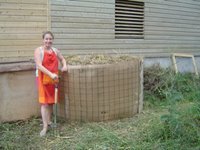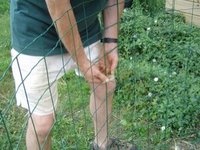

We’ve just gone large with our composting. We use straw for bedding in both the hen and goose houses and so are accumulating large amounts of it, along with grass cuttings, far too much for our one metre cube compost heap. I’d built that out of old pallets and wire mesh to make it rat-proof (see 30th May blog. With a combination of just dirty straw and grass cuttings, I don't think that there will be such a risk of encouraging rats as with the mix that contains kitchen waste, so we were able to use a different design.
On the “Solutions!” page of issue 48 of Permaculture Magazine was a letter from Chris Dixon of Wales, who explained how he dealt with large quantities of manure (!) and therefore had a similar problem to us. His solution was to create a very simple compost “bin” out of some old sheep fencing and some cardboard. We don’t have any old sheep, and hence any old sheep fencing, so I bought 6 metres from a local hardware shop. If you are a regular reader of our blog you might have started to see a pattern in my design process and so, not to disappoint, I did cock up yet again. Despite carefully employing the formula for the circumference of a circle (2 x π x r) I managed to confound radius with diameter (yes, I do know the difference, just made a mistake) so we’ve ended up with a huge compost heap with a diameter of 2 metres and so an enormous capacity of just over 3 metres cubed.
Not by design then, but we had enough material to fill it up, so it turned out well; what some friends of ours, Eva and Alan, call a “good bad’un”, a golfing term, apparently. Our experience with the first heap is that it will rot down at a rate that we can add more material without running out of space. We transferred some of the already rotting material from the base of the first heap to the new one to introduce useful bacteria and organisms. We now have adequate composting capacity and now know we can add another very easily when required. To make yours, form the wire fencing into a circle, bend over the ends to hook over the other end, then line with cardboard to retain the compost and fill up (see photos above).
